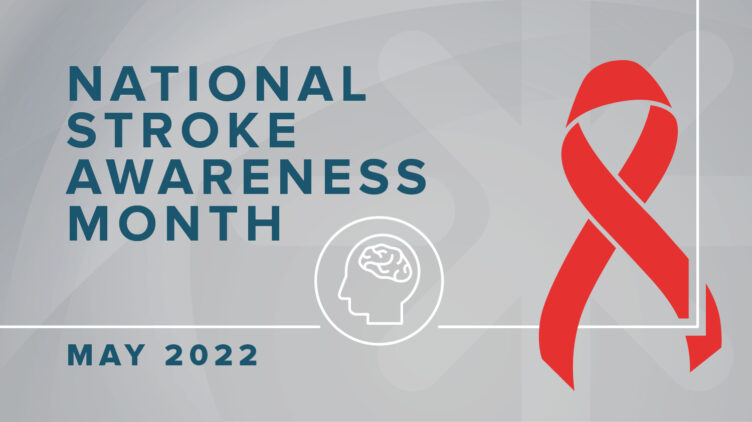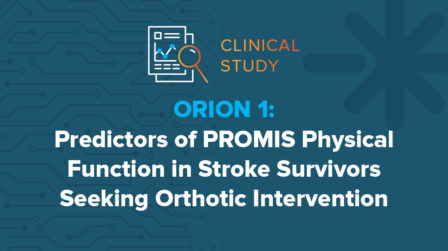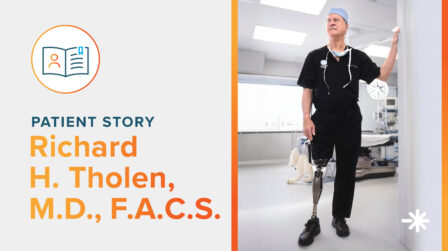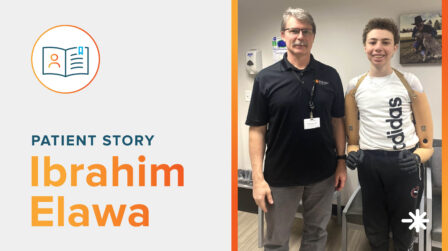Stroke Awareness | Orthoses in the Management of Stroke

Stroke is a leading cause of serious long-term disability, resulting in reduced physical function and mobility. Orthoses are clinically proven to help stroke survivors by providing stability, safety, and efficiency while walking. With October 29 being World Stroke Day and May being National Stroke Awareness Month, we have an opportunity to improve stroke awareness.
Someone in the United States has a stroke every 40 seconds.1 Every year, that results in more than 795,000 people experiencing a stroke in the United States alone.1 Stroke is also a leading cause of serious long-term disability.1 It substantially impacts mobility in more than half of stroke survivors age 65 and over,1 subsequently leading to a group of post-stroke survivors who may be candidates for orthotic intervention.
What Happens During a Stroke?
Our blood vessels carry oxygen and nutrients to the brain. A stroke occurs when a blocked artery (an ischemic stroke) or a leaking or bursting blood vessel (a hemorrhagic stroke) reduces the blood supply to the brain. When the brain is deprived of oxygen and nutrients, brain cells die and the damage can vary from mild to severe – or can even be fatal.
Effects of Stroke
The effects of stroke can be vast, affecting physical, cognitive, emotional, communicative, social, and functional activity. Stroke often has a negative impact on an individual’s physical function and mobility. Depending on the severity of the stroke, it has the potential to limit the ability to walk, balance, and maintain a level of independence conducive to a high quality of life.2 Common problems after a stroke include:
- Stiff muscles such as calf muscles that don’t work as they should
- Lack of knee and hip stability
- Weakness on one side or in the ankles
- Incorrect ankle position during the gait cycle
- Foot drop or a lack of dorsiflexion during the swing phase of the gait
- Toe contact at the initial stance phase of the gait
- Challenge achieving a normal gait
Approach to Treating Stroke
Effective treatment and rehabilitation of stroke patients require a multidisciplinary team approach. Treatments are often targeted at improving physical function with the goal of regaining as much functional independence as possible. Stroke patients often experience a proprioceptive issue, so when they walk they must learn to use both the right and left sides.
Ankle-foot orthoses (AFOs) have been shown to facilitate recovery of physical function such as walking speed, balance, and energy efficiency.3-6 The goal of a specially-fitted custom orthosis is to help stroke survivors maintain their range of motion, provide a better sense of support during weight-bearing, help achieve proper gait mechanics, and provide stability, safety, and efficiency while walking. It is also important to take into account the patient’s desire to increase mobility, ability to care for themselves, and overall goals and lifestyle. An AFO is customized to the symptoms a patient is exhibiting and muscle strength at various points in the leg and foot. The design of an AFO can vary between several types to meet the needs of the patient – flexible, semi-flexible, rigid, or hinged. Each patient should be assessed as an individual.
Assessing a Stroke Patient
“Stroke survivors may have residual effects including numbness or paralysis at the foot, ankle, and knee, commonly on only one side of the body. When the muscles that lift the foot during walking are affected, the foot may “drop” and catch the ground as the leg swings forward, this is a condition known as foot-drop. The weakened leg also affects standing balance and complicates walking patterns. One of the most effective strategies to assist this condition is to use an ankle-foot-orthosis (AFO). AFOs have been shown to provide many benefits for improving gait biomechanics and balance after a stroke, including increased walking speed, a more symmetrical gait pattern, improved foot clearance during swing, decreased risk of falls, and decreased energy expenditure.”
Eric Weber, LCPO, FAAOP, Clinical Research Associate, Hanger Institute for Clinical Research and Education

Latest Stroke Research
The Hanger Institute for Clinical Research and Education published research aimed at identifying the predictors of self-reported physical function of individuals seeking orthotic intervention post-stroke.

Stroke patients exhibit significant physical impairment. Studies such as ORION 1 continue to support the need for a patient-centric model that understands the difficulties of the patient and works to restore function to the patient.
Shane Wurdeman, PhD, CP, FAAOP (D), Director, Hanger Institute for Clinical Research and Education
Patient Education
Some patients may view an orthosis as a sign of a disability and resist wearing it from a psychological perspective. It is important to educate patients about how an AFO can be a long-term preventative measure to save the bones, joints, and spine. A multidisciplinary team has the greatest opportunity to make an impactful long-term difference.
Connect With a Hanger Clinic Orthotist
If you are interested in establishing a relationship with an orthotist in your area, we’d love to connect with you to see how we can work together.
References
[1] Virani SS, Alonso A, Benjamin EJ, Bittencourt MS, Callaway CW, Carson AP, et al. Heart disease and stroke statistics-2020 update: a report from the American Heart Association. Circulation. 2020;141(9):e139-e596.
[2] Schneider S, Taba N, Saapar M, et al. Determinants of longterm health-related quality of life in young ischemic stroke patients. J Stroke Cerebrovasc Dis. 2021;30(2):105499.
[3] Tyson SF, Kent RM. Effects of an ankle-foot orthosis on balance and walking after stroke: a systematic review and pooled meta-analysis. Arch Phys Med Rehabil. 2013;94(7):1377–1385.
[4] Tyson SF, Sadeghi-Demneh E, Nester CJ. A systematic review and meta-analysis of the effect of an ankle-foot orthosis on gait biomechanics after stroke. Clin Rehabil. 2013;27(10):879–891.
[5] Daryabor A, Yamamoto S, Orendurff M, et al. Effect of types of ankle-foot orthoses on energy expenditure metrics during walking in individuals with stroke: a systematic review. Disabil Rehabil. 2020. DOI:10.1080/09638288.2020.1762767.
[6] Daryabor A, Arazpour M, Aminian G. Effect of different designs of ankle-foot orthoses on gait in patients with stroke: a systematic review. Gait Posture. 2018;62:268–279.
Latest Updates
Subscribe to stay up-to-date on our latest posts.


